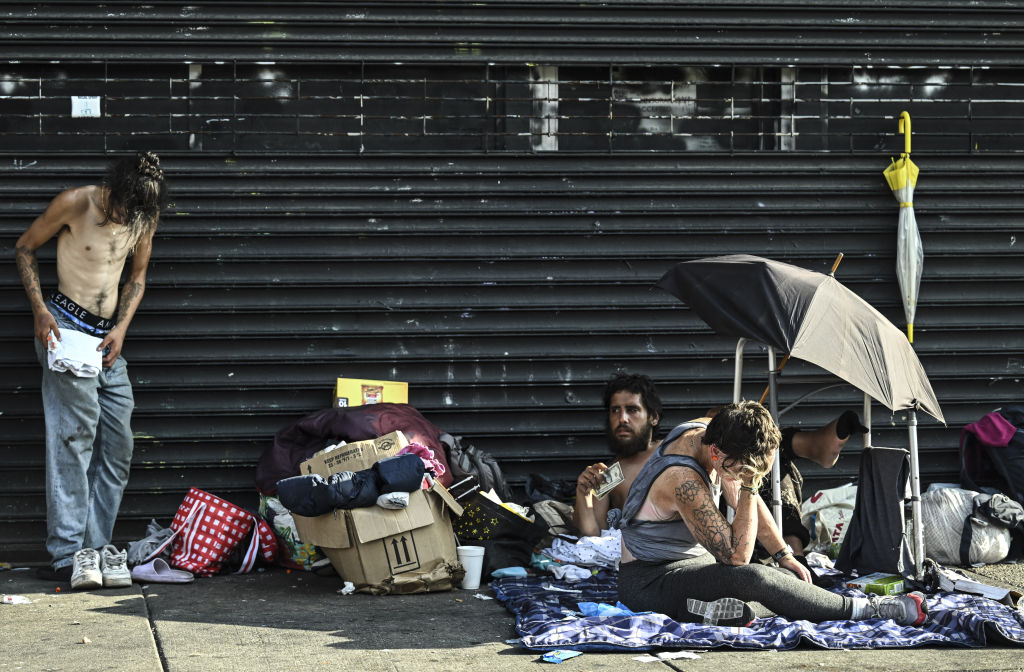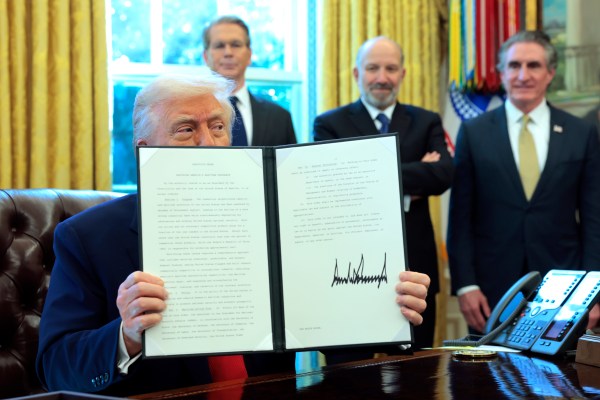As we enter the general election campaign for president, with fears of how polarization and declining trust in the integrity of elections might tip into political violence, Americans are again concerned about the future of their country. These concerns parallel the dynamics I study in fragile states worldwide, so I am often asked: Isn’t America fragile, too?
At face value, this question doesn’t really make sense. The United States is nothing like Syria, Nigeria, or Afghanistan. Our government is democratically elected and stable, the institutions function comparatively well, and the dynamic business sector makes day-to-day living more comfortable than almost anywhere on Earth. American advances in science and technology are the envy of the world. And the U.S. receives the largest number of immigrants from across the globe and remains a beacon for people seeking a better life. As a state, a lot of things are going right.
But if we consider fragility from a different angle, America is fragile. And it’s fragile in a way fragile states tend not to be: Americans face a growing deinstitutionalization of social life, especially at the local level. We might say America is a fragile society, with many problems that fragile states typically don’t have: family disintegration, school shootings, teens committing suicide, skyrocketing rates of depression, and deaths of despair—from alcoholism, drug abuse, and loneliness. Indeed, no country in history has had such material wealth alongside such unprecedented social decay.
Understanding the challenges fragile states face can help us understand our national cleavages as well as the local social breakdown that many of our fellow citizens experience. A state’s ability to navigate its challenges is chiefly determined by the capacity of its population to cooperate and the ability of its institutions (formal and informal) to channel this cooperation. These two factors shape how a government interacts with its citizens; how officials, politicians, military officers, and businesspeople behave; and how effective foreign efforts will prove in upgrading governance. In short, they determine how effective governance is, especially when it’s needed most. As America experiences unprecedented deinstitutionalization, there is a concomitant decline in citizens’ capacity to cooperate across differences. This is because institutions are where friction is forged into cohesion, as individuals work together to solve shared problems. To address the challenges that make America a fragile society, we’ll need to strengthen the institutions that bring people together at local, state, and national levels.
Social cooperation and American fragility.
As a start, it’s important to understand that roughly one-third of the world’s states are fundamentally fragile because they lack both the cohesion necessary to lubricate cooperation as well the bridging mechanisms (e.g, effective judicial systems, widely accepted electoral processes, national service, high schools and universities that integrate populations, abundance of cross-partisan civic associations) necessary to manage conflict. Deficient in both, fragile states such as Nigeria and Iraq struggle to address their challenges. They cascade from crisis to crisis—often under the threat of political violence—making it extremely hard to build the institutions necessary to ensure stability and jumpstart economic development.
Political fragmentation and weak governing bodies fuel each other, severely undermining the legitimacy of the state and producing highly unstable political orders that are hard to reform. In the absence of apolitical state bodies capable of distributing public services and applying the law evenly (and lacking the capacity to create them), the fragile state falls into a vicious cycle that is hard to overcome. As such, whereas robust states have strong national cohesion (or at least widely accepted institutions to manage differences), in fragile states the strongest cohesion is local—built on strong ethnic, religious, tribal, and family connections. These provide the best support in daily life while the state is viewed suspiciously.
As this fragile states framework makes clear, while the United States has some concerning developments, it is currently not fragile as a state. Polarization has hurt our social fabric but has neither divided us in the way countries such as Syria and Somalia are divided nor undermined our robust conflict management institutions in a way that would irrevocably change the nature of competition between groups. The United States has always been less vulnerable here because of the Founders’ wisdom—the Constitution’s system of checks and balances distribute power among three national institutions and state governments.
But given the rise in both rhetoric and political violence in recent years, it is worth asking why the United States is more polarized than comparably developed countries and what this says about the country's underlying social and institutional dynamics—and whether these are deteriorating to the point where the country would become genuinely fragile. Despite its many great assets, a country of alienated, weakly integrated and unembedded individuals is vulnerable to provocative political entrepreneurs and at risk of destabilizing democratic processes—producing ever more vicious disputes over electoral results and growing political violence.
What are some factors that make America a fragile society? First, like some of the most fragile states, America’s vast geographical landscape makes building social cohesion difficult, as in African countries such as the Democratic Republic of the Congo, Mali, Nigeria, and Sudan. In general, smaller states build cohesion more easily, and in Africa today the most unstable places are the largest—just as the most polarized developed country, the U.S., is the most sprawling. (Canada is larger geographically but the population is lower and less sprawling.) Relatedly, America’s growing geographical political segregation, exacerbated by the vast landscape, is something more likely to be found in states divided by identity such as Syria and Iraq than in affluent countries like France or Germany. This further inhibits the social integration, fraternal ties, and compromise that shared spaces and institutions once brought.
American society is also becoming deinstitutionalized, producing social problems at the local level, alongside more alienation and mistrust of national political processes than a healthy polity should have. While fragile states have little to hold them together nationally, they are much more resilient locally than contemporary America because their thick local institutions provide ample support in tight-knit local communities. As such, whereas in fragile states distrust is a natural product of alienation from the national government, in America the detachment from local institutions is at least significantly responsible. Local social disintegration is feeding alienation nationally.
Americans were once deeply engaged in a rich place-based associational life—as Alexis de Tocqueville so vividly described in the early 19th century, and 20th scholars such as Robert Putnam and Theda Skocpol have documented in recent years. Because Americans lived in bounded towns and neighborhoods built around shared, overlapping institutions—churches, schools, retail stores, place-based civic associations, public spaces, and interfamily networks—they were deeply intertwined with the lives of others. Associational life provided ample opportunity to interact with people of different classes and political leanings, appreciate different views, and work with, negotiate, and compromise with others, both locally and beyond. This ensured the country was well connected vertically and horizontally.
While all developed countries have seen a weakening of social bonds and the institutions that support them, this process has gone much further in the United States than elsewhere. Institutionalized associational life has withered, with functional social networks emerging from specific experiences (e.g., university) or geared toward specific goals (professional or affinity groups) becoming much more important than place-based fraternity and improvement.
It’s worth nothing that this has yielded many gains for individual freedom and choice. Women, people of color, and others who faced discrimination and constraints in the old system have much more opportunity. And our economy has gained a lot from their contributions in the workforce, affording all of us access to far more choice, convenience, and comfort. But a society centered on individual choice, convenience, and comfort can make our ties to one another more vulnerable and marginalize many places and individuals.
What does such marginalization look like? Many low-income Americans and people of color are badly affected if they live in one of the growing numbers of distressed neighborhoods—according to Purpose Built Communities, there are roughly 825 in urban areas alone, with more in suburban and rural areas. But even affluent Americans are impacted by the “social poverty” of modern life. And the consequences of these dynamics filter their way into our politics. “If we don’t know our neighbors, aren’t active in local community life, pay for others to raise our children and service our elders, and try to buy our way into a good life, we pay a large price,” John McKnight and Peter Block write. “We produce, unintentionally as it might be, a weak family, a careless community, and a nation that tries hopelessly to revive itself from the top down.”
And while some places thrive, others suffer from a form of local governance failure akin to what the fragile states framework shows: Fragile states suffer nationally due to a similar combination of weak social bonds and institutions and isolation from more dynamic parts of the country. The resulting neighborhood effect (a term popularized by Harvard sociologist William Julius Wilson) yields a pattern of instability, violence, and poor economic prospects. These problems attract less attention in the daily news cycle than politics but are arguably much more devastating to the lives of tens of millions of Americans, and have a huge, albeit indirect, influence on the nature of politics.
The focus on place is key here, as restoring social cohesion and strengthening national institutions cannot happen without strengthening neighborhoods and their place-specific institutions.
Beyond politics and policy.
Policymakers struggle to address problems that are not the product of politics per se, and sure enough they have struggled to come up with ideas on how to address America’s growing social crisis. Better electoral rules, better policies, and better checks on power may all be useful, but they are unlikely to restore cohesion, reverse the pull of deinstitutionalization, and strengthen local institutions such that everyone feels vested in their place and country. As Edmund Burke wrote, “To be attached to the subdivision, to love the little platoon we belong to in society, is the first principle (the germ as it were) of public affections.”
We can pursue this across three levels of American society: national, states and localities, and neighborhoods.
A robust national service program could foster the cross-political relationships and fraternity (the state or feeling of friendship and mutual support within a group) that are missing today. This could be designed to offer ample opportunities for people from all segments of society to work together on practical initiatives that can help integrate our ever more diverse country. For example, Israel’s national military service creates bonds across all parts of a highly diverse society (some religious and Arabs do not) in a way that nothing comparable in the U.S. does. Ideally, the projects will be very local and nurture a greater appreciation of places currently lagging, helping these places retain and attract talent.
Even though the U.S. was built with a federal system, far too many policies, decisions about spending, and debates have been nationalized, weakening the opportunity to build cohesion at the state and local level—essential in such a large polity. This encourages national ambition on the part of advocacy groups, the professional class, and the nonprofit world, yielding zero sum competitions for power and influence and greater division and frustration than is necessary. Much like decentralization is commonly used to reduce the risk of conflict in fragile states, subsidiarity would allow more decisions to occur at the state and local level. This requires ensuring that a much greater share of government spending catalyzed local cooperation and empowered local communities—including at the neighborhood level—rather than working in a siloed, formulaic, distant fashion as is the case today. More energy and talent would flow there, and more people would see their states and localities as worthy of their loyalties, fostering cohesion bottom up rather than top down.
Lastly, we can reclaim neighborhoods as a central arena in people’s lives. Neighborhoods are not a topic often discussed in foreign policy circles, but it’s the geographical zone most apt to rebuild the social fabric that underpins everything else in our society. Every person should live in a flourishing neighborhood: a place filled with institutions and activities to tie them to their neighbors and access to social and economic opportunities that gives them confidence in their futures.
Leaders might reenvision the social landscape around clearly demarcated neighborhoods, with a renewed emphasis on bolstering in-person exchange and developing place-based “organizational life.” These are what give fragile states such a rich social life locally. These locales would each have community schools and a commercial center that can provide everyday facilities and services. Assets and associations like parks, libraries, public transit, community organizations, café, and bars can promote bonding. Government would be decentralized so neighborhoods or subregions have greater say in how resources are used, fostering more creativity, accountability, and state-social synergies.
America’s social crisis rarely receives the attention it deserves, possibly because many leaders are partially insulated from it by the neighborhoods and networks they belong to. But the breakdown that affects so many has great implications for whether America’s increasingly fragile society will pose greater risks to its politics and polity.





Please note that we at The Dispatch hold ourselves, our work, and our commenters to a higher standard than other places on the internet. We welcome comments that foster genuine debate or discussion—including comments critical of us or our work—but responses that include ad hominem attacks on fellow Dispatch members or are intended to stoke fear and anger may be moderated.
With your membership, you only have the ability to comment on The Morning Dispatch articles. Consider upgrading to join the conversation everywhere.